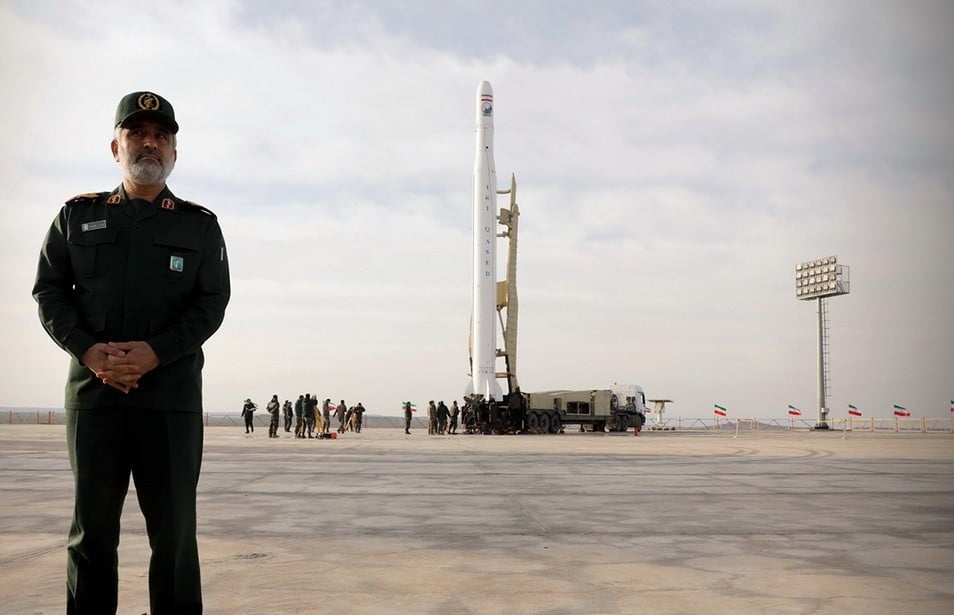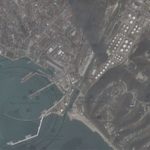With the successful space launch of the “Nour-1” spy satellite on April 22, the Islamic Republic of Iran has likely violated international sanctions. The trouble with Iran’s recent space launch is the delivery platform – the Qased Space Launch Vehicle (SLV) – not the payload – the “Nour-1” military satellite (mil-sat). As SLV technology is interchangeable with ballistic missile (BM) technology, space launches can help to extend missile range, increase stability and payload capacity.

Noor/ Nour-1 mil-sat launch on 22 April 2020. GEOINT analysis by T-Intelligence / Image courtesy of Planet Labs.
SPACE LAUNCH VEHICLE: FROM AND FOR BALLISTIC MISSILES
The “Qased” SLV (Courier in Persian) is a hybrid between the “Shahab-3” medium-range ballistic missile (MRBM), with which it shares the first liquid-fuel stage, and the “Salman” solid rocket engine that provided the technology for the second stage. The third stage is likely also solid-fuel based. The multi-stage rocket allowed Qased to reach an apogee of over 420 km, despite its heavy payload.
Video shows wreckage of the first stage of Qased SLV which crashed in Sistan & Baluchistan province in Southeast of #Iran. This is because the missile was launched from #Shahroud instead of being launched from somewhere close to open waters! pic.twitter.com/KLxQABuOFW
— Babak Taghvaee – Μπάπακ Τακβαίε – بابک تقوایی (@BabakTaghvaee) April 22, 2020
Iran’s proven ability to develop three-stage solid-fuel rockets, capable of boosting the payload at longer ranges and to higher altitudes than before, is a breakthrough in the pursuit of long-range and intercontinental ballistic missiles (ICBMs), which could reach the United States and all of Europe.

Amir Ali Hajizadeh, commander of Aerospace Force of Iran’s Islamic Revolutionary Guard Corps, stands in front of the Qased before launch. Photo credit: Tasnim news.
This is why Iran violated UNSC Resolution 2231, which calls on Iran to avoid “any activity related to ballistic missiles designed to be capable of delivering nuclear weapons, including launches using such ballistic missile technology.”
PAYLOAD ENABLES IRANIAN GEOINT CAPABILITY
Having the Nour-1 satellite in space is not a game-changer, although this will enable Iran to collect Geospatial Intelligence (GEOINT) without depending on third-parties. The mil-sat operates in the Low-Earth Orbit, namely in a 444 x 426 km orbit at 59.8 degrees inclination, and circles the Earth every 90 minutes (high temporal resolution), which makes it ideal for remote sensing. Nour-1 is believed to have a reasonably high resolution and will reportedly be joined by two other spy satellites in the future.

The upper photo shows Nour-1 completing a pass over the continental United States. The lower photo shows the satellite high above the northern Arabian peninsula. (Screenshot from a satellite tracker)
Nour-1’s success is, however, largely political and for domestic consumption. On the one hand, the launch has broken the decade-long spell of unsuccessful launches and stagnant research. On the other hand, it validated the IRGC-AF’s space program, which was responsible for the space launch, to the detriment of the Iranian Space Agency.
Founder of T-Intelligence. OSINT analyst & instructor, with experience in defense intelligence (private sector), armed conflicts, and geopolitical flashpoints.





